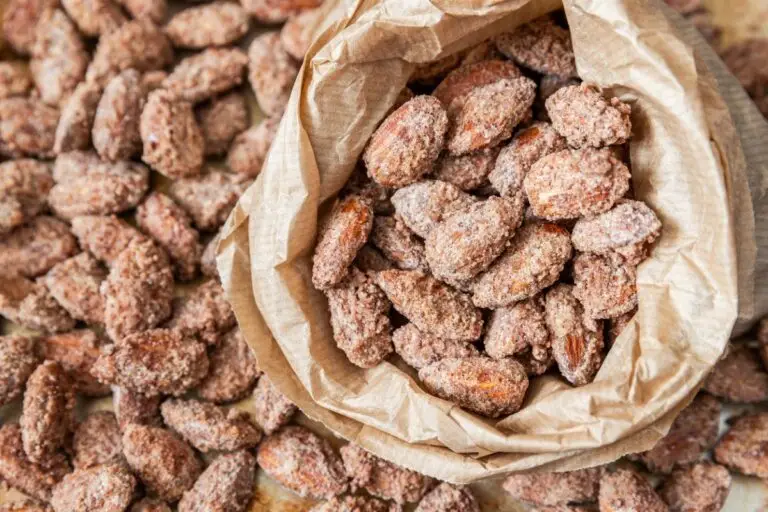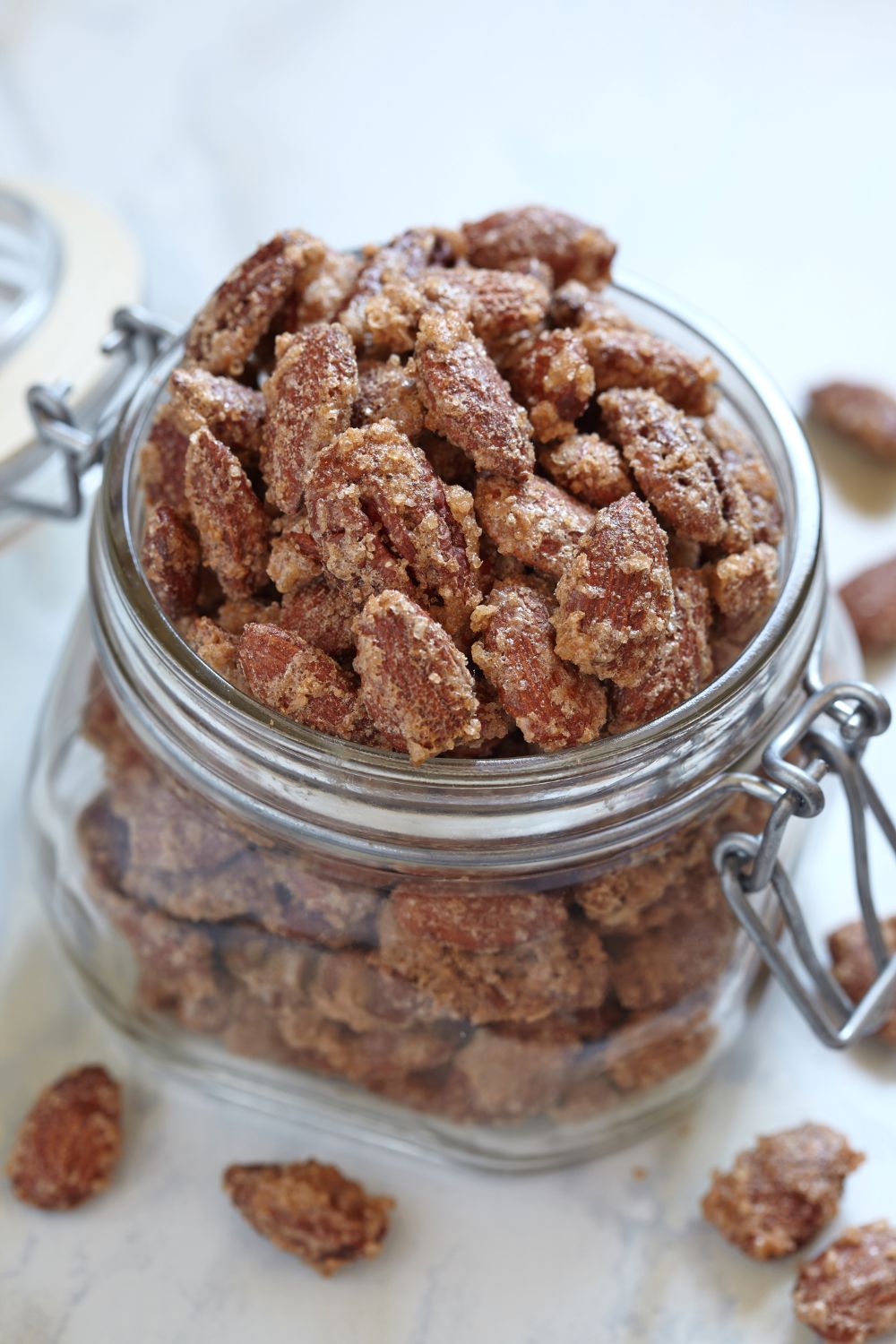This vintage candied almonds recipe delivers crunchy, spice-coated nuts in just over an hour with only seven simple ingredients from your pantry. This 1968 Better Homes and Gardens method rivals any Christmas market treat. Golden almonds glazed in cinnamon, cloves, and allspice create an aromatic coating that stays crisp for weeks. Perfect for holiday gifting or keeping a stash hidden for yourself!
Every October, my kitchen fills with the warm scent of toasted spices and caramelized sugar. This recipe came straight from my grandmother's 1968 Better Homes and Gardens cookbook, the red-checkered edition that lived on her kitchen counter for decades. The pages around this recipe are well-worn; evidence of countless holiday batches packed into tins for neighbors, teachers, and anyone lucky enough to receive them.
The 1968 Kitchen
The year was 1968, and American home cooks were discovering that homemade gifts carried more meaning than anything from a department store. Better Homes and Gardens was a leader in this movement, filling their magazines and cookbooks with recipes designed for sharing. Candied nuts appeared in nearly every holiday cookbook from that era, tucked between recipes for cheese balls and ribbon gelatin salads.
Home kitchens ran on Avocado Green or Harvest Gold appliances. Mixers stood ready on Formica counters, and ring-binder cookbooks, just like the iconic Better Homes and Gardens edition, lay open to dog-eared pages. Families grew their own vegetables in backyard victory gardens left over from wartime habits, and preserving food remained a practical skill rather than a trendy hobby.
Making candied nuts fit perfectly into this culture of thoughtful, economical homemaking. These treats required no special equipment beyond a mixing bowl and a baking sheet. The ingredients cost pennies. The recipe multiplied easily to fill dozens of gift tins. Most importantly, they transformed something ordinary—a handful of nuts—into something extraordinary through patience and care.
What Makes These Candied Almonds Special

Old-Fashioned Candied Almonds Recipe
This classic sugared nuts recipe brings together golden walnuts and almonds in a sweet, spiced coating that’s baked to perfection. The blend of cinnamon, cloves, and allspice creates a nostalgic, cozy aroma, making these crunchy treats irresistible for snacking, gifting, or holiday gatherings.
- Total Time: 1 hour + 10 minutes
- Yield: 8-10 servings 1x
Ingredients
- 2 tablespoons cold water
- 1 slightly beaten egg white
- 1/2 cup granulated sugar
- 1/2 teaspoon salt
- 1/4 teaspoon ground cinnamon
- 1/4 teaspoon ground cloves
- 1/4 teaspoon ground allspice
- 2 cups blanched whole almonds
Instructions
- Prepare the Coating:
In a medium mixing bowl, whisk together 2 tablespoons of cold water and 1 slightly beaten egg white. This will create a light, foamy mixture perfect for sticking all that sweet spice onto your nuts. - Blend in the Flavor:
Stir in 1/2 cup sugar, 1/2 teaspoon salt, and 1/4 teaspoon each of cinnamon, cloves, and allspice. The sugar adds a delicate crunch, while the spices fill your kitchen with an irresistible, comforting aroma. - Add the Nuts:
Pour in 2 cups of blanched whole almonds. Gently fold the nuts into the mixture, making sure each piece is evenly coated with the glossy, spiced syrup. Take your time here – thorough coating ensures sweet, even flavor in every bite. - Arrange for Baking:
Place the coated nuts onto a parchment-lined baking sheet (or use a silicone baking mat). Space them out a bit to prevent sticking and to help them crisp beautifully. - Bake:
Bake at 250°F (120°C) for about 1 hour. Check occasionally and stir or rearrange if the nuts look too clustered. This low and slow bake lets the sugar caramelize gently, turning each nut into a golden, crackly treat. - Cool:
Remove the nuts from the oven and let them cool on the baking sheet. As they cool, the candy coating will harden and give the nuts a festive, glossy finish.
Notes
Serve in decorative bowls for a retro party snack, or package in jars or treat bags for thoughtful homemade gifts.
- Prep Time: 10 minutes
- Cook Time: 60 minutes
- Category: Snacks
- Method: Baked
- Cuisine: American
Nutrition
- Serving Size: 2 Tablespoons
- Calories: 130
- Sugar: 7g
- Sodium: 76mg
- Fat: 9g
- Saturated Fat: 0.7g
- Carbohydrates: 10g
- Fiber: 1.9g
- Protein: 3.8g
- Cholesterol: 0
How to Make Perfect Candied Almonds
Recipe Variations, Serving Ideas, and Storage
Recipe Variations
Frequently Asked Questions
You can, though the coating won't adhere as smoothly to the wrinkled skins. Raw almond skins also add slight bitterness that competes with the sweet spice coating. If raw almonds are your only option, expect a more rustic appearance and slightly less coating coverage per nut.
Stickiness usually means underbaking or storing them before they cooled completely. The coating needs the full hour at 250°F to dry properly. Also check your humidity levels—candied nuts absorb moisture from humid air, turning sticky within days. Store in an airtight container with a silica gel packet in very humid climates.
Yes, though the texture changes significantly. Stovetop methods use water, sugar, and spices cooked until the water evaporates and sugar crystallizes on the nuts. This creates a more crystalline, less smooth coating. Alternatively, use aquafaba (chickpea liquid) as a vegan egg white substitute—3 tablespoons equals one egg white.
Stir them every 15 minutes during baking to separate any that cluster. If they still clump, break them apart immediately after removing from the oven while they're still warm and pliable. Once cooled in a mass, separating them becomes nearly impossible without damaging the coating.
Absolutely. Use two baking sheets so the nuts bake in a single layer. Rotate the pans halfway through baking and swap their oven positions to ensure even browning. Doubling the recipe is smart for gift-giving—this makes about 2 cups, which fills roughly three small gift jars.
Blanched almonds provide a smooth, even surface for the coating to adhere. The papery skin on raw almonds prevents proper coverage and adds bitterness. You can blanch raw almonds yourself by boiling them for 60 seconds, then slipping off the skins, though buying them pre-blanched saves significant time.
Yes, they're ideal for advance preparation. Make them up to three weeks ahead and store in airtight containers at room temperature. Package them closer to gift-giving day to ensure maximum freshness. Many vintage recipes specifically highlight make-ahead convenience as a major selling point for busy holiday cooks.
Clear cellophane bags tied with festive ribbon show off the glossy coating. Small mason jars with fabric toppers look charming on a coffee bar. For mailing, use tins or rigid containers to prevent crushing during shipping. Include a "Best By" date three weeks from packaging.
Cold water helps control the egg white's temperature as you whisk it, preventing premature cooking or curdling when mixed with room-temperature ingredients. It also slows down the incorporation speed, giving you better control over the frothy texture you're aiming for. Room temperature water works in a pinch, but avoid warm water entirely.
These candied almonds carry forward a tradition of thoughtful, homemade gift-giving that defined the late 1960s American kitchen. The beauty lies in their simplicity! Seven ingredients, one hour of patient baking, and the satisfaction of creating something far superior to anything store-bought.
What holiday treats did your grandmother make that you'd love to recreate? If you make this old-fashioned candied almonds recipe, please leave a rating and review below. I love hearing which batch disappeared fastest at your house!



0 comments